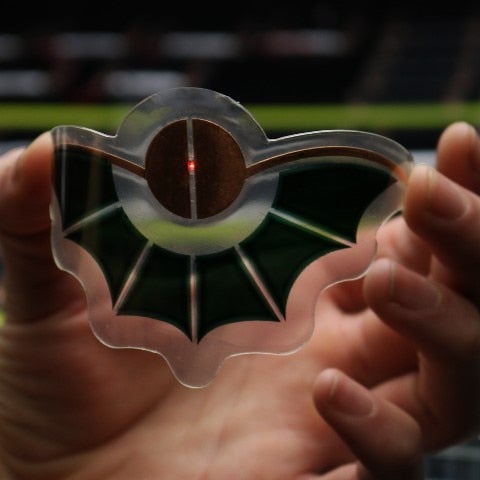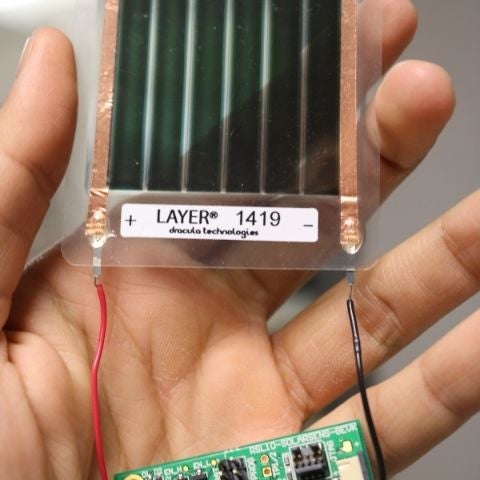It is expected that billions of IoT devices will be installed over the coming years, with almost half of them being used in indoor environments. Currently, the use of batteries to power these devices places significant constraints on their development.
Dracula Technologies is a deep tech start-up with expertise in digital printed organic photovoltaic (PV) modules and is the creator of LAYER® (Light As Your Energetic Response), an innovative technology that is able to generate energy from ambient light (natural or artificial) in order to support low power consumption indoor IoT sensor nodes. For its contributions to sustainability, LAYER® was recently recognized as a CES Innovation Award honoree.
In taking our LAYER technology from within a laboratory to producing hundreds of modules per week, we have seen the needs of IoT OEMs evolve and become closely aligned to what our organic photovoltaic (PV) technology delivers in terms of performance, customization and low ecological footprint. We have witnessed a significant trend from semiconductor solution providers to reduce the overall energy consumption of their components and increase battery life in order to reduce maintenance costs and the ecological impact of battery disposal.
To demonstrate the capabilities of LAYER, we developed a Proof of Concept (PoC) of a solar-powered indoor wireless sensor node and selected the RSL10 Solar Cell Multi-Sensor Platform from ON Semiconductor for the integration. The RSL10 Solar Cell Multi-Sensor Platform is a user-friendly kit that allowed us to manage the power delivered by LAYER® and demonstrate it was possible to extend an IoT device’s lifespan by combining energy harvesting with low energy consumption electronic components. As LAYER is only one part of the solution (the harvester), it was essential to find a system solution to demonstrate how energy harvesting with LAYER can power Bluetooth® Low Energy technology enabled autonomous sensors. The RSL10 Solar Cell Multi-Sensor Platform was a perfect match and allowed us to develop our PoC with ease.
Figure 1. PoC developed using Dracula Technologies’ LAYER and RSL10 Solar Cell Multi-Sensor Platform
For our PoC, we required a system solution with the following features:
• Low power Bluetooth LE connectivity,
• Ease of implementation with our LAYER technology,
• Support for different sensor types,
• Low power consumption,
• Small, compact form-factor,
• And support for a smartphone or PC interface to retrieve or visualize data.
Offering a range of low-power sensors and the industry’s lowest power Flash-based Bluetooth LE radio, the RSL10 Solar Cell Multi Sensor Platform from ON Semiconductor was the best system solution we could find to demonstrate the potential of energy harvesting with OPV technology. Before we discovered the RSL10 radio, the first prototypes we designed had several drawbacks mainly related to the electronic components and firmware used. Other Bluetooth LE-enabled radios required big bursts of energy during wake-up or while advertising. Another issue was that their firmware was not optimized to minimize energy consumption during these phases. The RSL10 was an ideal choice for our PoC as it only consumes 50 nA in deep sleep mode.
By combining the RSL10 Solar Cell Multi-Sensor Platform and Dracula Technologies’ LAYER®, we are able to provide IoT device manufacturers with a complete solution that fulfills their needs. Our PoC allows them to connect autonomous objects through efficient energy harvesting management. Our goal is to implement the install and forget system by removing the costs associated with maintenance, including battery replacement while providing a green and environmentally friendly solution.
Learn more about Energy Harvesting Platforms from ON Semiconductor, or check out these development resources below.
• RSL10 Solar Cell Multi-Sensor Platform User Guide
• Continuous Harvesters and ON Semiconductor’s Low−Power RF Technology Close the Gap in Environmental and Accelerometer Sensors for IoT White Paper
• RSL10 Datasheet
Be sure to subscribe to our blog and follow us on social media to receive the latest updates on our technologies, solutions and company news!
Twitter | Facebook | LinkedIn | Instagram | YouTube

